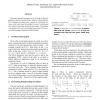100 search results - page 19 / 20 » Representing First-Order Logic Using Graphs |
ICDAR
2003
IEEE
13 years 10 months ago
2003
IEEE
er presents an approach to deriving an abstract geometric model of a table from a physical representation. The technique developed uses a graph of constraints between cells which ...
ERSHOV
2009
Springer
13 years 9 months ago
2009
Springer
A term t is called a template of terms t1 and t2 iff t1 = t1 and t2 = t2, for some substitutions 1 and 2. A template t of t1 and t2 is called the most specific iff for any template...
INTERNET
2007
13 years 5 months ago
2007
evel of abstraction, we can represent a workflow as a directed graph with operators (or tasks) at the vertices (see Figure 1). Each operator takes inputs from data sources or from ...
CIDR
2009
13 years 6 months ago
2009
Recent excitement in the database community surrounding new applications--analytic, scientific, graph, geospatial, etc.--has led to an explosion in research on database storage sy...
SIGSOFT
2002
ACM
14 years 6 months ago
2002
ACM
Program slicing is a potentially useful analysis for aiding program understanding. However, slices of even small programs are often too large to be generally useful. Imprecise poi...

